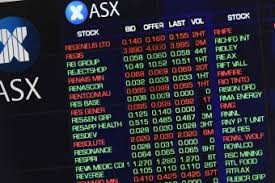Weekly email update - 2nd of April 2019
Written and accurate as at: Apr 02, 2019 Current Stats & Facts

US yield curve inversion has some expecting an American recession, while the Brexit saga provided a new twist each day as the British parliament neared – and then passed – the deadline by which its divorce from the EU was supposed to happen. Nevertheless, much of this news has been discussed previously, as such the local equity market remained unperturbed, down -0.2% for the week.
Metals & Mining outperformed -- the sub-index was up +1.8% as the iron ore miners rose in response to an operations update from Vale. The Brazilian miner’s new 2019 volume estimates take into account the effect of mine closures and disruptions from the review into the safety of its tailings dams. Latest guidance suggests that, even with some deployment of existing inventory, the cut in volumes will be at the upper end of the market’s range of expectations.
Fortescue Metals (FMG, +7.9%), Rio Tinto (RIO, +4.0%) and BHP (BHP, +2.3%) all outperformed on the view that FY19 iron ore prices will be higher than previously thought.
That was in stark contrast to Alumina (AWC, -7.3%) and South32 (S32, -3.6%) which came off as Norsk Hydro and Brazilian prosecutors agreed to the steps by which the Alunorte aluminium refinery – the world’s most significant – could return to full production.
Alunorte has been running at 50% production since breaching pollution regulations in early 2018, which has seen tighter aluminium markets. Signs of agreement in Brazil potentially signal the end of this sweet spot for the Australian-listed producers.
While Metals & Mining did well, the broader Resources sub-index only rose +0.2%.
Oil and gas stocks were among the week’s worst performers. LNG is typically priced off oil, but there’s been a short-term divergence between the two benchmarks with LNG weakening as oil remains steady.
There are a couple of factors at play here, including reports of LNG inventory over-build during the northern hemisphere winter, along with recent addition of volumes from the Icthys and Prelude projects in WA’s Browse Basin.
The upshot is that people are tempering their expectations for the contracted rates for delivery of Australian gas to Asia. Woodside Petroleum (WPL, -3.3%), Origin Energy (ORG, -4.8%), Santos (STO, -5.0%) and Oil Search (OSH, -5.1%) all weakened in response.
Listed property gained +0.6% for the week and was the most robust sector for the month, up +6.2% versus +0.2% for the general market. Housing stocks are showing some signs of life. Auction data has come in better than expected, even as listings remain depressed and new dwelling starts also continue to fall. The result is some nuance in the outlook for housing-related stocks, albeit caution remains on companies linked to construction.
There was some divergence among the Industrials.
Stocks such as Dominos Pizza (DMP, +5.4%), Sydney Airport (SYD, +3.9%), Qantas (QAN, +3.9%) and Nine Entertainment (NEC, +3.3%) jumped after a soggy patch. Conversely, Orica (ORI, -5.0%), AMP (AMP, -4.6%) and Computershare (CPU, -3.9%) gave back some recent gains. Challenger (CGF, +10.7%) was among the market’s best. It announced a deal with MS&AD Insurance which will give it greater access to the Japanese annuity market, helping to alleviate some of the issues from greater margin pressure.
Key retail stocks were also strong.
Harvey Norman (HVN +5.5%), Myer (MYR +4.2%) and JB Hi-Fi (JBH +3.8%) all experienced substantial gains. This was related to expectations of a generous stimulatory Federal budget this week. While some handouts have been flagged, most believe the government will be unwilling to undermine its claims of fiscal prudence, and we see the risk of over-optimism on the budget outcome.
More broadly, many do not believe the yield curve inversion is indicating a near-term recession in the US. The Fed’s period of possible over-tightening was relatively brief, and the damage to the economy will be limited. That said, we would not be surprised to see equity markets tread water following a strong first quarter. The market has re-rated in relief at the Fed’s change of tack and is now at a valuation which may be sustainable given the renewed outlook for domestic interest rates.
A key risk remains the prevailing view of economic growth. Any deterioration could see valuations fall. In this vein, data remains generally supportive, with more signs of Chinese resilience emerging over the weekend. However, this remains a crucial area to watch in the coming weeks and months.










